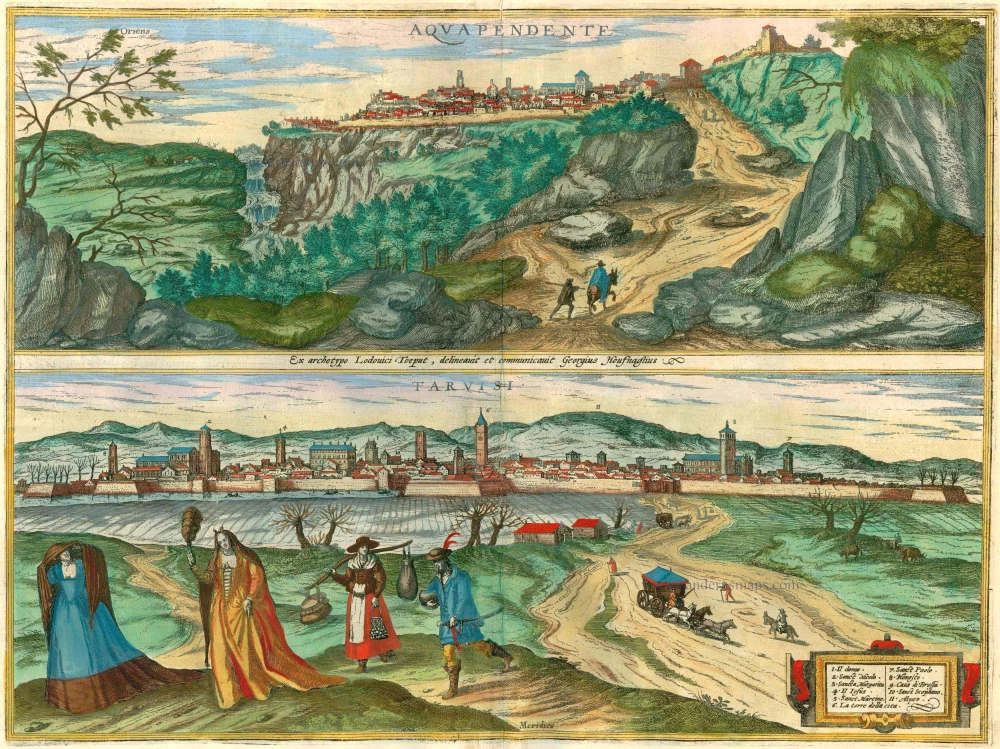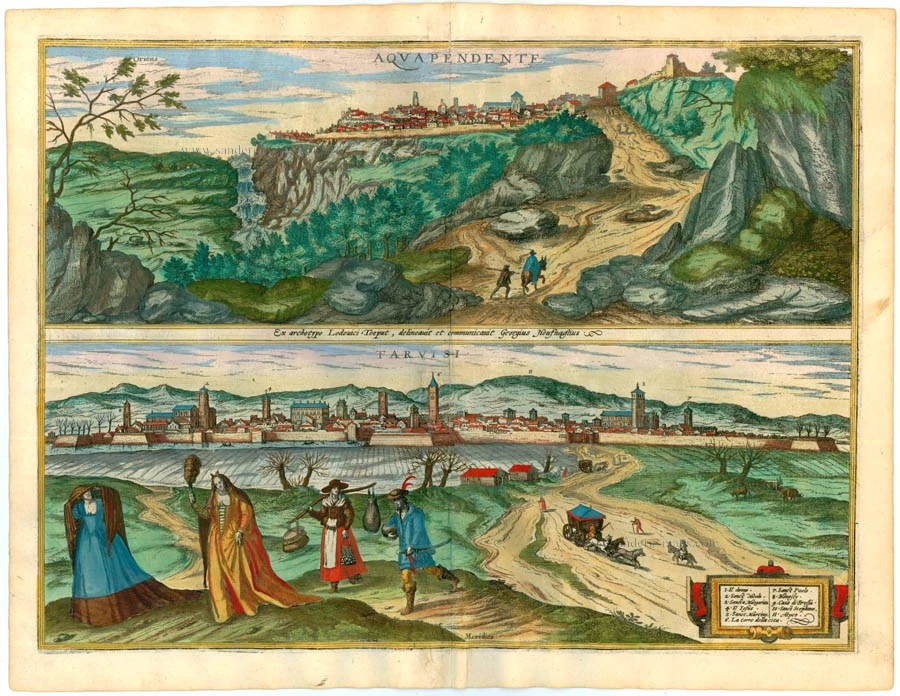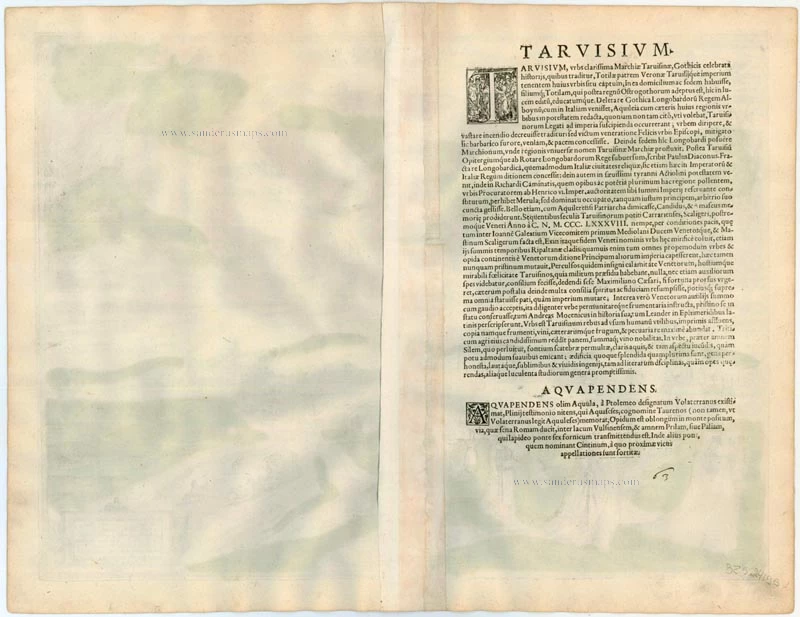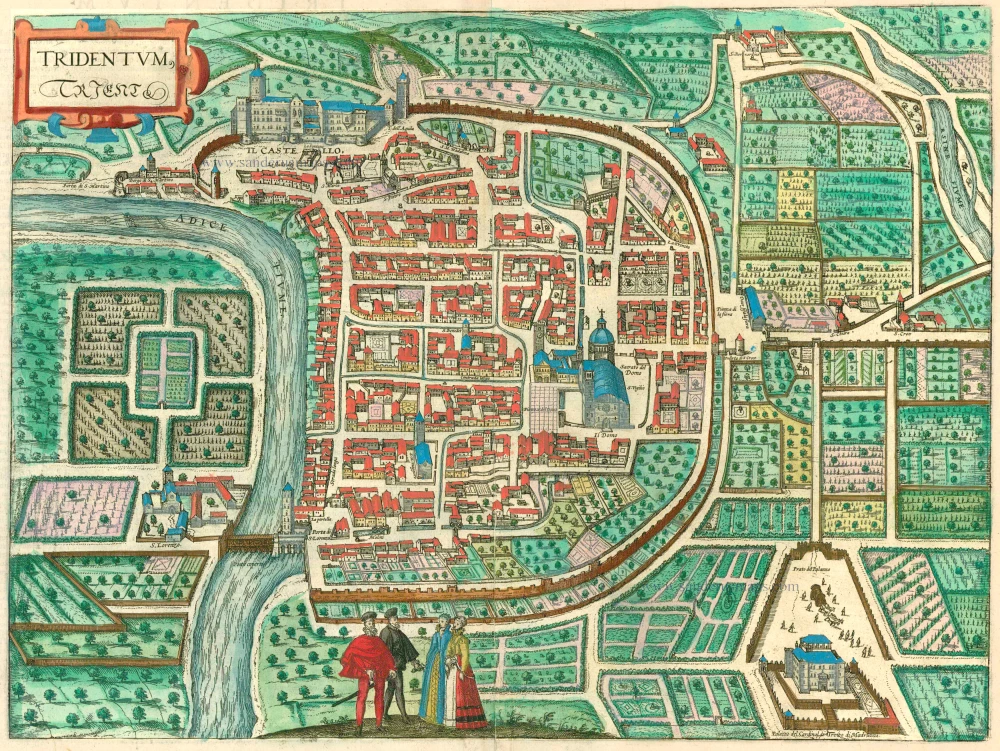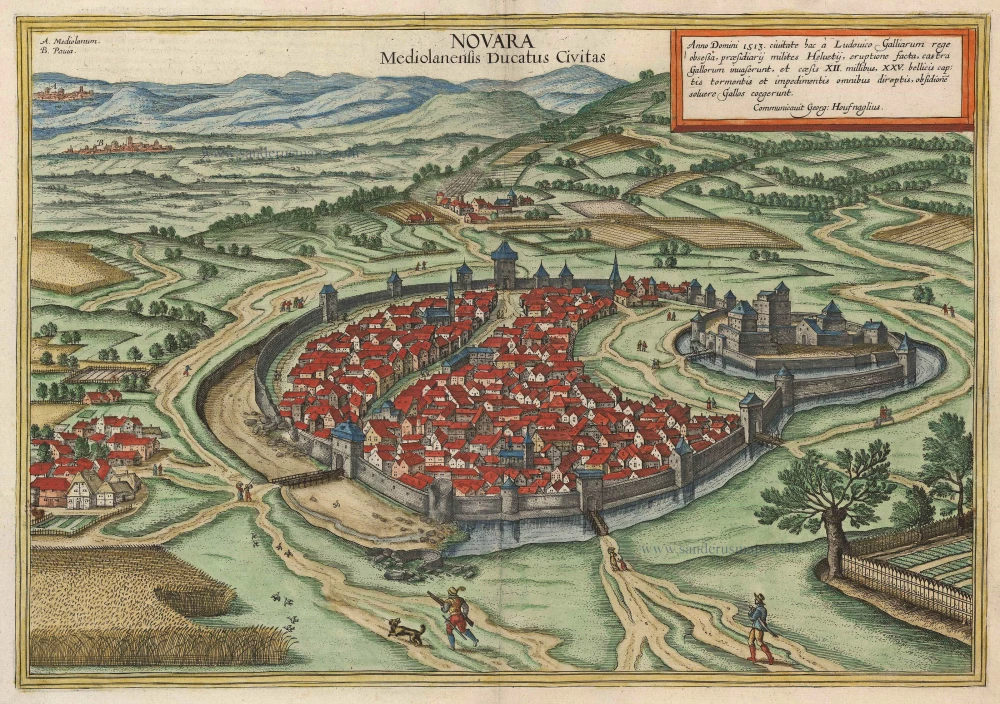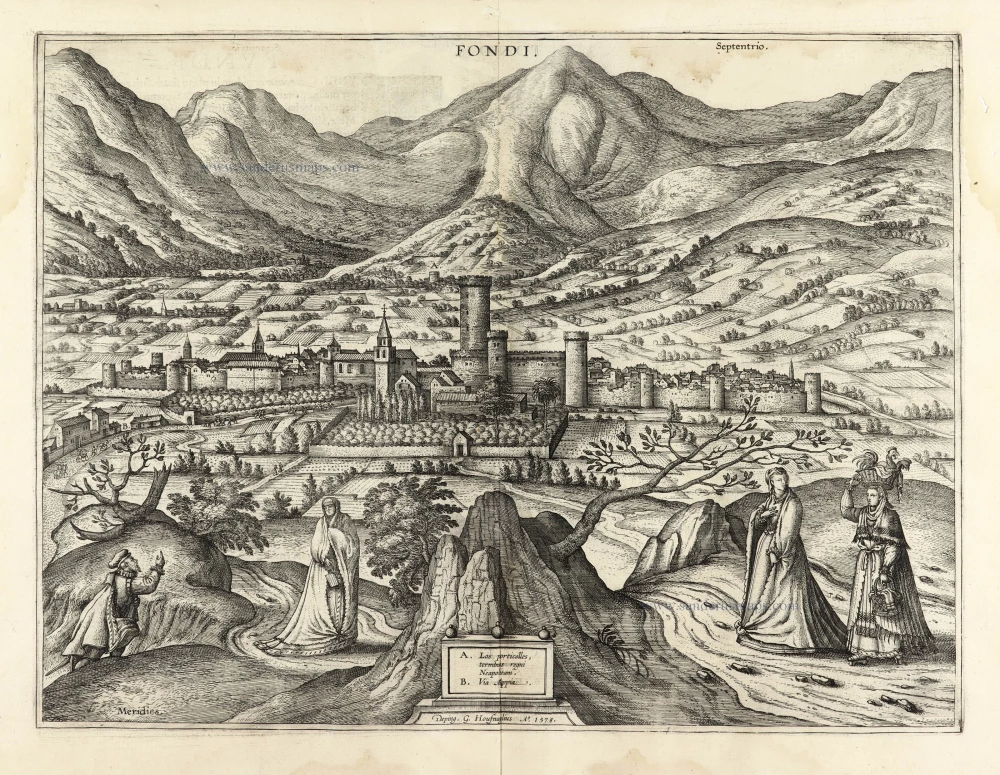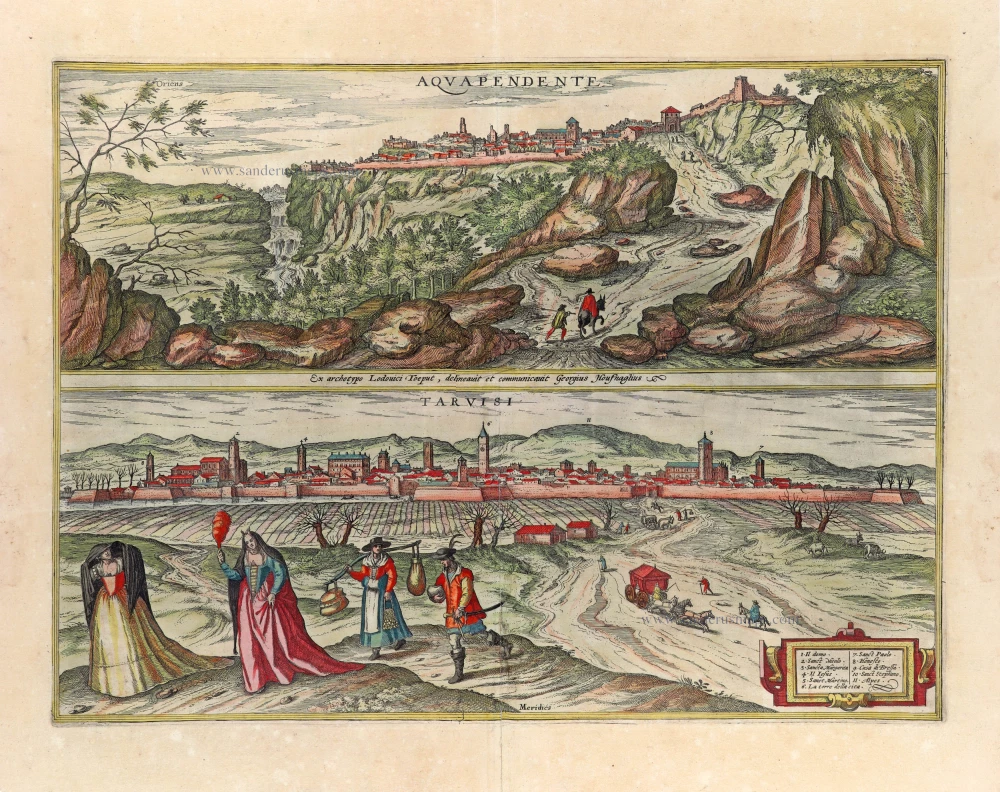Acquapendente and Tarvisio by Braun and Hogenberg after Ludwig Toeput and Joris Hoefnagel.i 1596-1640
ACQUAPENDENTE
COMMENTARY BY BRAUN (on verso): "Acquapendente is a small, strung-out town on a mountain, on the road from Siena to Rome, between the Lago di Bolsena and the River Paglia, which is crossed by a bridge with six spans."
The view from the west highlights the town's dramatic location on a precipitous rock terrace. On the left of the town lies the cathedral of San Sepolcro, and in the centre, the church of San Francesco, whose prominent bell tower dates from the Renaissance. On top of the hill on the far right lies the Monastero di Santa Chiara, built in 1333 on a site formerly occupied by an imperial fortress. Acquapendente, which in 1499 became part of the Papal States, lies north of Lake Bolsena on the road that leads from Siena to Rome via Viterbo.
TREVISO
COMMENTARY BY BRAUN (on verso): "Treviso is a noble town in the March of Treviso and very famous in the history of the Goths since the father of King Totila, who ruled in Verona and Treviso, took particular delight in this town and lived there himself, and his son Totila, who later became king of the Ostrogoths, was born and educated there. The city of Treviso has all the necessities of life in abundance, for it is very well supplied with grain, wine, other fruits and cattle. The city on the River Sile has many drinking fountains and magnificent buildings and houses."
The fortified city of Treviso is seen from the south, in its picturesque setting on the banks of the Sile River, with the Alps (11) in the background. The tallest tower in the city is the Torre del Comune (6) on the Piazza dei Signori, which is surrounded by palaces with open arcades. Further left is the cathedral of San Pietro (1). Further left again is the Dominican church of San Nicolò, an example of Romanesque and Gothic brick architecture. The chapterhouse contains a fresco cycle by Tomaso da Modena that includes the earliest representation of a pair of spectacles. The tall, unlabelled tower between the cathedral and the Torre del Comune probably belongs to the church of San Francesco, part of a Franciscan monastery founded in the early 13th century. Buried in the church are two children of famous Italian poets: a son of Dante and a daughter of Petrarch. (Taschen)
Braun G. & Hogenberg F. and the Civitates Orbis Terrarum.
The Civitates Orbis Terrarum, also known as the 'Braun & Hogenberg', is a six-volume town atlas and the most excellent book of town views and plans ever published: 363 engravings, sometimes beautifully coloured. It was one of the best-selling works in the last quarter of the 16th century. Georg Braun, a skilled writer, wrote the text accompanying the plans and views on the verso. Many plates were engraved after the original drawings of a professional artist, Joris Hoefnagel (1542-1600). The first volume was published in Latin in 1572 and the sixth in 1617. Frans Hogenberg, a talented engraver, created the tables for volumes I through IV, and Simon van den Neuwel made those for volumes V and VI. Other contributors were cartographers Daniel Freese and Heinrich Rantzau, who provided valuable geographical information. Works by Jacob van Deventer, Sebastian Münster, and Johannes Stumpf were also used as references. Translations appeared in German and French, making the atlas accessible to a broader audience.
Since its original publication of volume 1 in 1572, the Civitates Orbis Terrarum has left an indelible mark on the history of cartography. Seven more editions followed the first volume in 1575, 1577, 1582, 1588, 1593, 1599, and 1612. Vol.2, initially released in 1575, saw subsequent editions in 1597 and 1612. The subsequent volumes, each a treasure trove of historical insights, graced the world in 1581, 1588, 1593, 1599, and 1606. The German translation of the first volume, a testament to its widespread appeal, debuted in 1574, followed by the French edition in 1575.
Several printers were involved: Theodor Graminaeus, Heinrich von Aich, Gottfried von Kempen, Johannis Sinniger, Bertram Buchholtz, and Peter von Brachel, all of whom worked in Cologne.
Georg Braun (1541-1622)
Georg Braun, the author of the text accompanying the plans and views in the Civitates Orbis Terrarum, was born in Cologne in 1541. After his studies in Cologne, he entered the Jesuit Order as a novice, indicating his commitment to learning and intellectual pursuits. In 1561, he obtained his bachelor's degree; in 1562, he received his Magister Artium, further demonstrating his academic achievements. Although he left the Jesuit Order, he continued his studies in theology, gaining a licentiate in theology. His theological background likely influenced the content and tone of the text in the Civitates Orbis Terrarum, adding a unique perspective to the work.
Frans Hogenberg (1535-1590)
Frans Hogenberg was a Flemish and German painter, engraver, and mapmaker. He was born in Mechelen as the son of Nicolaas Hogenberg.
By the end of the 1560s, Frans Hogenberg was employed upon Abraham Ortelius's Theatrum Orbis Terrarum, published in 1570; he is named an engraver of numerous maps. In 1568, he was banned from Antwerp by the Duke of Alva and travelled to London, where he stayed a few years before emigrating to Cologne. He immediately embarked on his two most important works, the Civitates, published in 1572 and the Geschichtsblätter, which appeared in several series from 1569 until about 1587.
Thanks to large-scale projects like the Geschichtsblätter and the Civitates, Hogenberg's social circumstances improved with each passing year. He died as a wealthy man in Cologne in 1590.
Aquapendente [on sheet with] Tarvisi
Currently not available
Item Number: 24195 Authenticity Guarantee
Category: Antique maps > Europe > Italy - Cities
Acquapendente and Tarvisio by Braun and Hogenberg after Ludwig Toeput and Joris Hoefnagel.
Title: Aquapendente [on the sheet with] Tarvisi.
Date of the first edition: 1596.
Date of this map: 1596-1640.
Copper engraving, printed on paper.
Size (not including margins): 365 x 490mm (14.37 x 19.29 inches).
Verso: Latin text.
Condition: Excellent, superb old colour.
Condition Rating: A+.
From: Civitates Orbis Terrarum, ... Part 5. Köln, 1596-1640.
ACQUAPENDENTE
COMMENTARY BY BRAUN (on verso): "Acquapendente is a small, strung-out town on a mountain, on the road from Siena to Rome, between the Lago di Bolsena and the River Paglia, which is crossed by a bridge with six spans."
The view from the west highlights the town's dramatic location on a precipitous rock terrace. On the left of the town lies the cathedral of San Sepolcro, and in the centre, the church of San Francesco, whose prominent bell tower dates from the Renaissance. On top of the hill on the far right lies the Monastero di Santa Chiara, built in 1333 on a site formerly occupied by an imperial fortress. Acquapendente, which in 1499 became part of the Papal States, lies north of Lake Bolsena on the road that leads from Siena to Rome via Viterbo.
TREVISO
COMMENTARY BY BRAUN (on verso): "Treviso is a noble town in the March of Treviso and very famous in the history of the Goths since the father of King Totila, who ruled in Verona and Treviso, took particular delight in this town and lived there himself, and his son Totila, who later became king of the Ostrogoths, was born and educated there. The city of Treviso has all the necessities of life in abundance, for it is very well supplied with grain, wine, other fruits and cattle. The city on the River Sile has many drinking fountains and magnificent buildings and houses."
The fortified city of Treviso is seen from the south, in its picturesque setting on the banks of the Sile River, with the Alps (11) in the background. The tallest tower in the city is the Torre del Comune (6) on the Piazza dei Signori, which is surrounded by palaces with open arcades. Further left is the cathedral of San Pietro (1). Further left again is the Dominican church of San Nicolò, an example of Romanesque and Gothic brick architecture. The chapterhouse contains a fresco cycle by Tomaso da Modena that includes the earliest representation of a pair of spectacles. The tall, unlabelled tower between the cathedral and the Torre del Comune probably belongs to the church of San Francesco, part of a Franciscan monastery founded in the early 13th century. Buried in the church are two children of famous Italian poets: a son of Dante and a daughter of Petrarch. (Taschen)
Braun G. & Hogenberg F. and the Civitates Orbis Terrarum.
The Civitates Orbis Terrarum, also known as the 'Braun & Hogenberg', is a six-volume town atlas and the most excellent book of town views and plans ever published: 363 engravings, sometimes beautifully coloured. It was one of the best-selling works in the last quarter of the 16th century. Georg Braun, a skilled writer, wrote the text accompanying the plans and views on the verso. Many plates were engraved after the original drawings of a professional artist, Joris Hoefnagel (1542-1600). The first volume was published in Latin in 1572 and the sixth in 1617. Frans Hogenberg, a talented engraver, created the tables for volumes I through IV, and Simon van den Neuwel made those for volumes V and VI. Other contributors were cartographers Daniel Freese and Heinrich Rantzau, who provided valuable geographical information. Works by Jacob van Deventer, Sebastian Münster, and Johannes Stumpf were also used as references. Translations appeared in German and French, making the atlas accessible to a broader audience.
Since its original publication of volume 1 in 1572, the Civitates Orbis Terrarum has left an indelible mark on the history of cartography. Seven more editions followed the first volume in 1575, 1577, 1582, 1588, 1593, 1599, and 1612. Vol.2, initially released in 1575, saw subsequent editions in 1597 and 1612. The subsequent volumes, each a treasure trove of historical insights, graced the world in 1581, 1588, 1593, 1599, and 1606. The German translation of the first volume, a testament to its widespread appeal, debuted in 1574, followed by the French edition in 1575.
Several printers were involved: Theodor Graminaeus, Heinrich von Aich, Gottfried von Kempen, Johannis Sinniger, Bertram Buchholtz, and Peter von Brachel, all of whom worked in Cologne.
Georg Braun (1541-1622)
Georg Braun, the author of the text accompanying the plans and views in the Civitates Orbis Terrarum, was born in Cologne in 1541. After his studies in Cologne, he entered the Jesuit Order as a novice, indicating his commitment to learning and intellectual pursuits. In 1561, he obtained his bachelor's degree; in 1562, he received his Magister Artium, further demonstrating his academic achievements. Although he left the Jesuit Order, he continued his studies in theology, gaining a licentiate in theology. His theological background likely influenced the content and tone of the text in the Civitates Orbis Terrarum, adding a unique perspective to the work.
Frans Hogenberg (1535-1590)
Frans Hogenberg was a Flemish and German painter, engraver, and mapmaker. He was born in Mechelen as the son of Nicolaas Hogenberg.
By the end of the 1560s, Frans Hogenberg was employed upon Abraham Ortelius's Theatrum Orbis Terrarum, published in 1570; he is named an engraver of numerous maps. In 1568, he was banned from Antwerp by the Duke of Alva and travelled to London, where he stayed a few years before emigrating to Cologne. He immediately embarked on his two most important works, the Civitates, published in 1572 and the Geschichtsblätter, which appeared in several series from 1569 until about 1587.
Thanks to large-scale projects like the Geschichtsblätter and the Civitates, Hogenberg's social circumstances improved with each passing year. He died as a wealthy man in Cologne in 1590.

